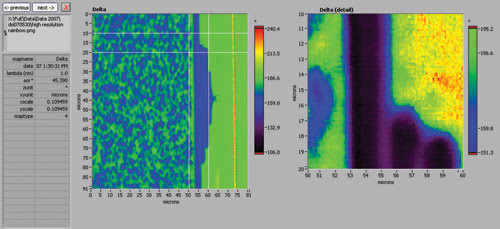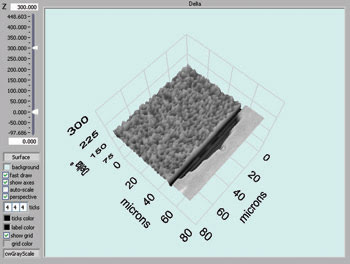Jörg Schwartz
GÖTTINGEN, GERMANY -- The computers we rely on trust magnetic drives to store all the data we try to wedge into them. This presents designers with a double-edged sword: how to increase capacity while shrinking size.
A little help from photonics could ease the burden.
Although we know that the actual storage is done by magnetic domains, such as on a good old tape recorder, these domains have become incredibly small, supported by the effect of giant magnetoresistance, whose discovery was honoured with a Nobel Prize in physics in 2007.
Imaging ellipsometry could aid in creating both bigger and smaller hard drives.
The Nanofilm Surface Analysis division of Halcyonics GmbH in Göttingen, Germany, in collaboration with Data Storage Institute of Singapore, has demonstrated read-write heads of hard drives using imaging spectroscopic ellipsometry (see Physica Status Solidi (a), 1-7 2008). Related technologies, including imaging ellipsometry and nonimaging spectroscopic ellipsometry, have been used in the past, one for direct visualization of ultrathin lubricant films on the magnetic disks and the other for quality control of read-write heads.
However, the combination of those two now allows the taking of micrographs of the head surfaces, enabling generation of an optical model consisting of titanium carbide in an aluminium matrix and including surface roughness and concentration gradients of the two materials.
Ellipsometry measures the change in the polarization state of light reflected from the surface of a sample. The measured values are expressed as delta and psi, which are related to the ratio of Fresnel reflection coefficients for the two principal polarization states of the light. Those values can be used to build and optimize a model of the surface that determines its composition and thickness. Spectroscopic ellipsometry performs such measurements at more than one wavelength of interest to obtain additional data and, if a CCD sensor is used instead of a standard photodetector, spatial resolution is added to the measurement technique, which is then referred to as imaging spectroscopic ellipsometry.

Delta and psi measurands of ellipsometry contained data on surface optical properties.
The method offers testing resolution down to 1 μm, about the size of the TiC grains on the magnetic strips of the magnetic poles of drive heads. In comparison, the spatial resolution of nonimaging ellipsometry, even with the microspot option, is typically only 30 μm – not sufficient for this purpose.

Detail of a portion of the area shown in the first figure.
The developers have shown that, using the imaging technique, a representation of the granular TiC/Al2O3 structure in terms of n and k (being the real and complex parts of the refractive index) can be obtained from the ellipsometric parameters delta and psi. This allows optimization of magnetic structures on the hard drive heads so that even smaller magnetic domains can be accessed, thus supporting further reduction of storage size or increasing storage density.
So, if you’ve been waiting to tidy up your hard drive, wait a little longer. A larger one may be out there soon.